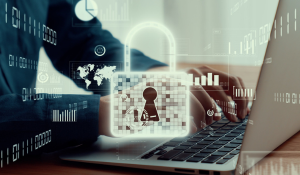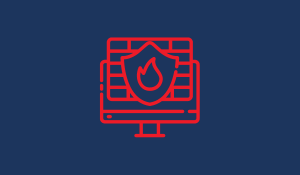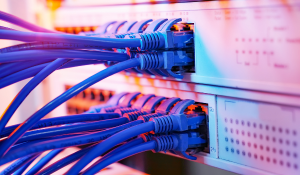How packet filtering works explained
Cyber threats are constantly on the rise and organisations are faced with the challenge of protecting their networks from a wide range of attacks and...
5 min read
 DriveLock
May 14, 2024 2:34:04 PM
DriveLock
May 14, 2024 2:34:04 PM

In the age of digital communication and internet access, content filtering has become an indispensable part of cyber security. The ability to control access to content based on predefined rules and criteria plays a crucial role in ensuring the security of networks, devices and users.
| TABLE OF CONTENT |
In this blog post, we will take an in-depth look at the concept of content filtering, discuss its importance for IT security and discuss best practices for implementing an effective content filtering system.
Content filtering is a process in which content is filtered or selected based on certain criteria. This process can be automated or manual and is often used in various digital environments such as networks, web browsers, email services and other platforms.
Content filtering can have various objectives, including:
Content filters are often used to block harmful or unwanted content such as malware, phishing attempts, spam or inappropriate content to ensure user safety.
In some cases, organisations must adhere to certain policies or regulations that restrict access to certain types of content. Content filtering helps to fulfil these compliance requirements by restricting access to inappropriate or non-compliant content.
In corporate environments, content filtering can help increase employee productivity by restricting access to non-work related or distracting content.
The criteria by which content is filtered can be varied and include keywords, categories, URLs, file types, sender information and more. Modern content filtering systems often use complex algorithms and technologies such as artificial intelligence and machine learning to effectively analyse and filter content.
Content filtering plays a crucial role in IT security by enabling organisations to detect and block harmful content, protect sensitive data and comply with policies.
1 |
Protection against malware and phishing: Content filtering can detect and block harmful content such as malware, viruses and phishing links before they can harm users. By blocking malicious content, organisations can reduce the risk of infection and data loss. |
2 |
Preventing data leaks: By filtering sensitive or confidential information, content filtering systems can prevent confidential data from being inadvertently or intentionally leaked. This is particularly important in organisations where the protection of sensitive data is paramount. |
3 |
Compliance with guidelines and regulations: Content filtering enables companies to comply with guidelines and regulations that restrict access to certain types of content. This can include legal regulations such as the General Data Protection Regulation (GDPR) in Europe or industry-specific regulations. |
4 |
Protection against inappropriate content: Content filtering can block inappropriate or adult content that is unsuitable for certain user groups, such as children in schools or employees in work environments. By blocking such content, organisations can ensure a safer and more appropriate working or learning environment. |
5 |
Increasing productivity: By restricting access to non-work related or distracting content, content filtering systems can help to increase employee productivity. By limiting access to social media, games and other non-productive content, employees can utilise their time more effectively. |
Overall, content filtering helps to improve the security and integrity of IT systems and networks by blocking unwanted or harmful content while allowing access to authorised content.
Content filtering typically works by analysing content based on predefined rules or criteria. Here is a basic description of how content filtering typically works:
Content analysis: The content, be it a website, an email, a file or another digital data set, is analysed. This can be done at different levels, depending on the type of content and the technologies available. For example, texts can be searched for specific keywords, images can be checked for visual characteristics, and URLs can be checked for known patterns of malicious websites.
Comparison with filter rules: The analysed content is then compared with a set of filter rules. These rules can be set by administrators or developers and define what type of content is acceptable or unacceptable. Examples of filter rules can include blocking websites with certain keywords, filtering emails from certain senders or blocking file attachments with suspicious file types.
Decision-making: Based on the result of the analysis and the comparison with the filter rules, a decision is made as to whether the content is allowed or blocked. If the content matches the filter rules, it is normally allowed. Otherwise, it is blocked or treated according to the defined guidelines. These decisions can be made automatically by content filtering systems, or they can be monitored and authorised by administrators.
User interaction: In some cases, content filtering may require user interaction. For example, a user may receive a warning when trying to access a blocked web page and can then choose whether or not to continue accessing it. In other cases, users can report certain content or request that certain filtering rules be adjusted.
Overall, content filtering aims to recognise and block unwanted or harmful content, while at the same time allowing permitted content. Modern content filtering systems often use complex algorithms and technologies to enable effective and reliable filtering.
To achieve optimal results, organisations must adhere to a set of best practices tailored to their specific needs and challenges. Find out what the best content filtering practices are in IT security.
Regularly update filter rules and signatures: It is important to regularly update filter rules and signatures to detect and block emerging threats. This includes regularly updating malware signatures, URL blacklists and other filtering criteria.
Use of multiple filtering technologies: Combining different filtering technologies, such as text analysis, image recognition and behavioural analysis, can enable effective detection and blocking of malicious content. By diversifying filtering technologies, blind spots can be reduced and the effectiveness of content filtering increased.
Customisable policies: Content filtering solutions should offer flexible and customisable policies that allow organisations to control access to content based on their individual security requirements. This includes the ability to customise policies for different user groups, locations and devices.
SSL/TLS inspection: As many malicious activities take place in encrypted traffic, it is important to use SSL/TLS inspection technologies to check and filter the content of encrypted connections. This enables organisations to detect and block malicious content even in encrypted traffic.
User awareness and training: In addition to technical solutions, it is important to educate users about the importance of content filtering and the risks of harmful content. Training and awareness campaigns can help to raise awareness of security risks and encourage employees to make a conscious decision to adopt security-conscious behaviour.
Logging and monitoring: Comprehensive logging and monitoring of the content filtering system enables organisations to identify suspicious activity, investigate security incidents and evaluate the effectiveness of their content filtering policies.
By implementing these best practices, organisations can improve the effectiveness of their content filtering and strengthen their IT security at the same time.
Content filtering is an essential tool in today's connected world to ensure the security of organisations and users. By implementing best practices and continuously adapting to new threats, organisations and institutions can build an effective content filtering system.
This system helps to block malicious content, protect sensitive data and ensure compliance. By understanding and responding to the importance of content filtering, together we can create a safer and more trusted digital environment.

Cyber threats are constantly on the rise and organisations are faced with the challenge of protecting their networks from a wide range of attacks and...

Are you ready to fortify your digital defenses and safeguard your network from cyberattacks? Look no further than the network firewall. A formidable...

A proxy server acts as an intermediary between a client and a server. It allows clients to establish indirect network connections to other servers...